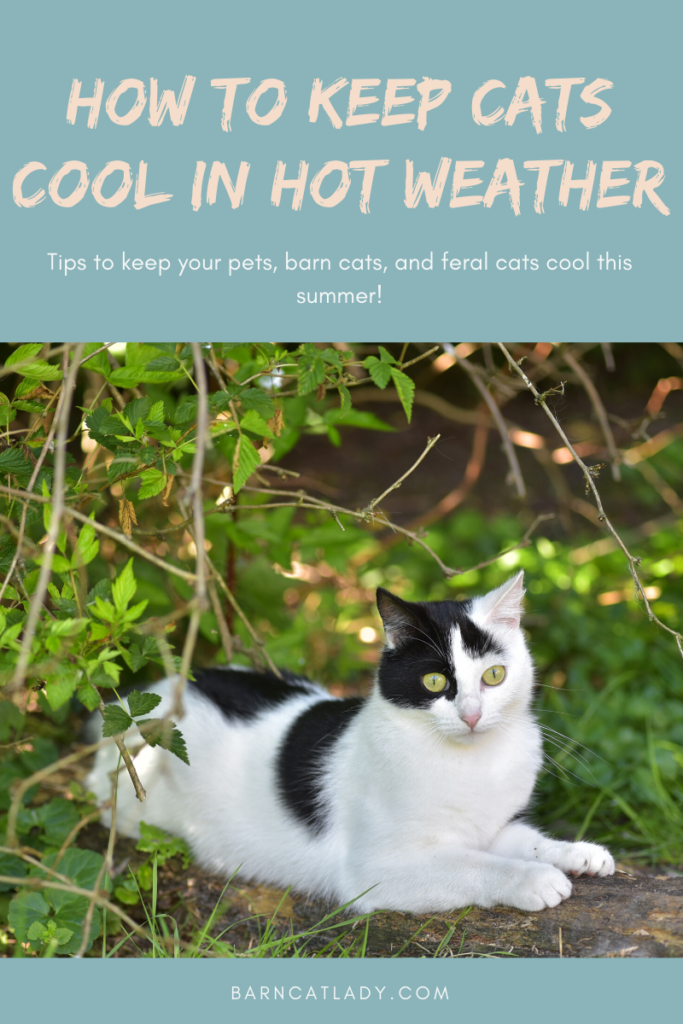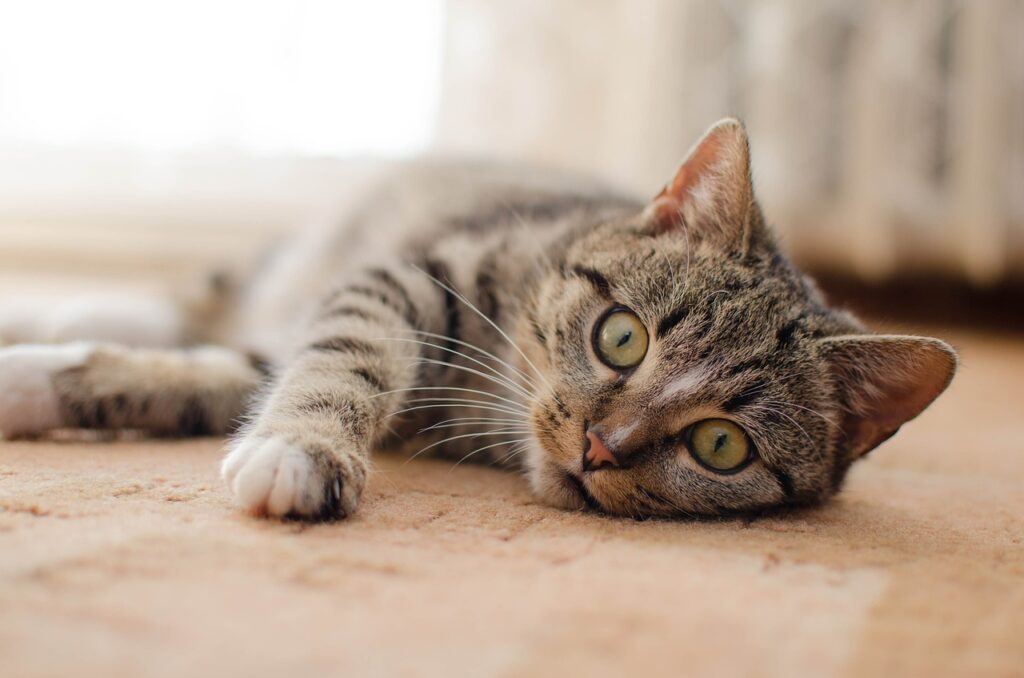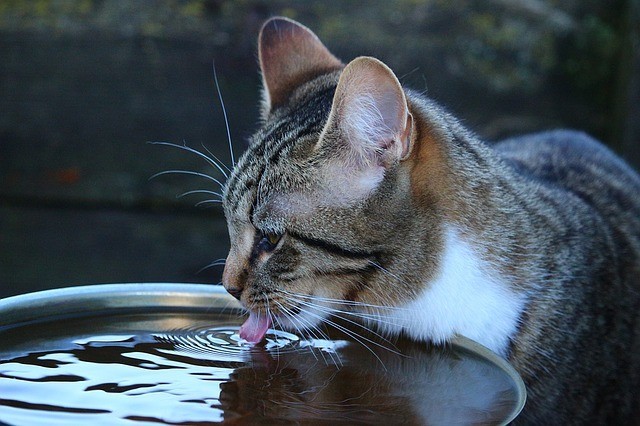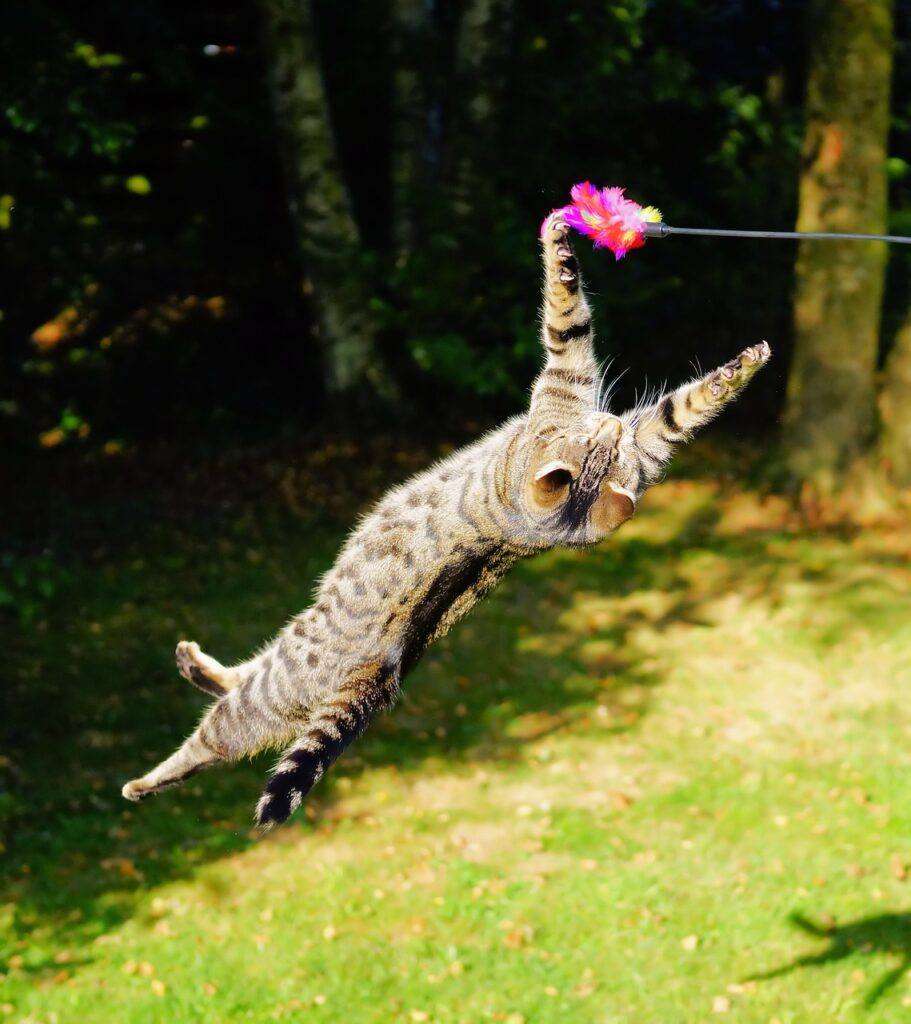
As June is almost here, as well as scorching temperatures, it’s time to consider how to keep cats cool in hot weather.
This is easy for those of us with pet cats as most of us will just keep them inside with the air conditioner. Problem solved.
Except, what about walking your cat or the poor outdoor cats? Barn cats, feral cats, and stray cats don’t have that luxury. Community cats have to rely on their instincts to keep them cool in the summer as they don’t usually have access to air-conditioned homes.
As feral cat caretakers (adopted as barn cats or not), we should give them a little help to stay healthy in hot weather. While cats are usually quite good at taking care of themselves, we should help alleviate some of their discomfort. Cats get hot just like humans do.
We’ll discuss exactly how cats cool themselves down and how you can help to keep cats cool in hot weather as well. Even feral cats, that you can’t touch.
Feline Behavior and Biology in Hot Weather
Cats are actually not very prone to overheating when left to their own devices.
Cats (and dogs) are considered hydrotherms, which means they maintain a fairly constant body temperature of 101 to 102 degrees Fahrenheit. They do this by adjusting internal heat gain and heat loss to maintain a constant body temperature.
So what does that mean? It means they don’t usually need help cooling off.
Cats (and dogs) can sweat through their paws, and it IS a sign of being hot, but sweating is not a biological method to cool themselves off. The surface area of a cat’s paw is too small for that to be an effective method of cooling their bodies.
How do cats cool themselves?
Cats cool themselves in a few ways.
The first is by lying on cooler objects, like the cement floor in the shade or a basement or the bathroom tile. This method of cooling themselves is called conduction, by the way. It’s basically transferring heat away from themselves when they lie on cool surfaces.

Another method of cooling themselves is when they come into contact with cooler water or air, which is called convection. This occurs when they jump in a pool or have a fan trained on them. The heat is transferred away from their body through the cold water or air.
Cats also transfer heat away from themselves through panting, which is by evaporation.
Amazingly enough, their fur also helps to keep a cat cool!
Say what? You thought it was only to keep them warm in cold weather? Nope!
Cat (and dog) fur also serves to help an animal by preventing them from taking on too much heat in warm weather.
The thick undercoat that a cat has in winter is what keeps a cat warm in cold weather. You may notice that your cat colony all look fluffier or thicker in the winter because they grow some thick coats to combat the cold weather outside! During warmer months, cats lose the thick undercoat.
The remaining outer-coat that’s left in summer is actually optimal to handle the heat, as long as it is not extreme. That’s why it can be a mistake to shave or cut your pet’s fur in the summer! It can actually make a cat HOTTER in the summer if you shave them. Crazy, right? Plus their fur helps to prevent sunburn, skin cancer, and insect bites.
(Except for certain cats such as the Persian or other thick-coated breeds, shaving your dog or cat should be avoided. It is best to speak to a veterinarian before shaving your cat for heat purposes.)
Can Cats Get Too Hot?
Yes, they can! Just like humans, cats can suffer from heat exhaustion and heat stroke as well. That said, cats are not as likely as dogs to suffer from heat exhaustion or stroke. Why? Because cats aren’t often in the cars nor are they often taken out on walks.
Cats are also pretty concerned with their own comfort so they tend to seek ways to stay cool on their own. (Cats are smart enough to avoid it in most cases, in other words.)
However, cats can suffer illness from heat when accidentally caught in a dryer or when an outdoor cat gets trapped inside a shed (or other types of ‘oven-type’ structure) or when forced to run in mid-summer day heat.
Risk factors for heat illness in cats include breeds with dense fur coats or squishy faces, obesity, poor lung or heart health, and age.
Let’s discuss what happens when cats get TOO hot.
Symptoms of Overheating in Cats:
- Excessive Panting
- Rapid heart rate
- Dehydration
- Sunken eyes
- Little to no urine in the litter box
- Sweaty feet (cats sweat through glands in their paws; however, they do NOT sweat to cool themselves!)
- Disorientation
- Lying flat on the ground, stretched out flat.
- Vomiting
- Restlessness
- Lethargy
- Drooling or sticky/thick saliva
- Bright red tongue/mouth
- Rectal temperature is above 105° F (40.5° C)
- Seizures
- Coma
- Death
If you’re unaware, heatstroke can kill cats as well as people so it’s very important for cats (and dogs and people!) to not overheat in the summer.
How to Keep Cats Cool in Hot Weather
1. Drinking Water is Vital
The most important way to help cats in hot weather is to always, always, ALWAYS make sure your pet or cat colony has fresh, cool water to drink. Feel free to add ice cubes to it and change it multiple times a day.

2. Use the Air-Conditioner or a Retreat
If your cats are indoor-only, be sure to keep the AC running, even when you’re at work.
If you don’t have AC, then create a retreat for the cats, such as leaving the bathroom or basement door open so the cat can seek out the coolest area of the house.
3. Don’t Walk Your Cats During the Hottest Part of the Day
If you walk your cat on a harness, make sure to adjust the walking schedule so that you aren’t walking your cat during the hottest part of the day. If possible, early morning and late evening are the best times to walk your cats.
4. Shade
Make sure the outdoor cats (barn or strays) have access to shady areas. This could be as simple as putting a cat door leading into your garage or basement or by building something in your yard.
Anything that provides shade will help!
This is also important to keep indoor cats cool. Make sure the curtains and blinds are CLOSED during the day!
5. Brushing
Brush them, especially if they’re long-haired cats, as matted fur is HOT.
6. Keep Cats Out of Hot Buildings
Keep outdoor cats out of greenhouses, small sheds, etc. Make sure to double-check that cats are not inside before shutting them up!

7. Keep Kitties Calm
Physical activity will cause a cat to overheat if they’re forced to exert themselves in the middle of the day. This is why you don’t often see cats out and about in the middle of summer during the day. Most of them find cool areas to nap during the hottest part of the day.
8. Keep Your Cat Inside
I’m a firm believer in indoor-only pets that are only allowed outside with supervision or on leashes. Part of that reason is that outdoor cats, such as feral cats and barn cats, do not live as long as indoor cats. However, if you adopted a stray cat that insists on being allowed outside, then make sure to keep him indoors when it’s hottest outside.
9. Avoid Car Rides
If you have to take your cat to the vet in the summer, then be sure you NEVER leave him in the car with the vehicle off, not even for 5 minutes.
10. Dampen Your Cat’s Fur
No, don’t spray your cat or your feral cats! That just upsets them. However, by using a wet towel to dampen their fur, you will help their bodies cool down better. Especially on their bellies. Your cat does not need to be wet. Just a bit of moisture will help, especially on hot days.
Spraying feral cats with water is NOT a good idea as it will break their trust in you AND cause them to run, which defeats the purpose of ‘cooling’ them down with water.
11. Chicken Broth Flavored Ice Cubes
You can put this in their water or allow them to play or lick them on a tile floor, whatever. It helps cool them down indoors, especially when you don’t have air conditioning.
The chicken-flavored ice cubes can be added to water to help promote your feral and barn cats to drink more, which also helps to cool them down.
You could also use beef-flavored, as well.
12. Homemade Ice Packs
You can freeze plastic bottles of water (or whatever else your mind thinks up) and leave them wherever the cat likes lounging!
12. Turn the Fans On
Whether indoors or in barns, turn on those fans. Turn them on areas the cats are likely to hang out! Leave a fan going in a barn bathroom or a tack room. Moving air helps cool down our furry friends too!
13. Keep Hairless or White-Haired Cats Out of the Sun
Hairless cats, as well as those light-skinned, white-haired cats, are prone to getting sunburn.
There IS pet sunscreen you can buy. However, aks your veterinarian to recommend one as there is no sunscreen marketed for cats in the US at this time. Do NOT use human sunscreen without consulting a veterinarian as most contain an ingredient toxic to cats and dogs.
14. Feed Wet Food
Cats are designed to get moisture from their food as well as from actual water. That means by feeding wet food, you will help your cats stay hydrated. Keeping hydrated is very important to helping cats avoid heat-related illnesses.
Another bonus is that wet food, no matter what brand you can afford, is always more nutritious than dry food. So add wet food once or twice a day in addition to their dry food.
15. Pay Attention
Remember the symptoms of heatstroke in cats and watch them to be sure they aren’t getting too hot.
Chances are that the cats will be fine as they are good at staying cool all on their own, but if any of the symptoms of heatstroke are noticed, contact your veterinarian immediately!
Cats are Smart!
Chances are your cats (feral, barn, or pets) will not need your help to stay cool in hot weather as long as water and shade are available.
But it never hurts to give them a little help!
Do you have any tricks for keeping your cats (or dogs) cool during hot summer days? Tell me below!
Lovies!


I thoroughly enjoyed reading this post, with all the information on how cats keep themselves cool. Fascinating. Curiously though, why are squishy faced cats more prone to overheat?
Summer is truly a precarious time for pet owners everywhere. I own ferrets, who are a lot like cats and dogs, and from the sound of it, a bit more prone to overheat than cats are. The two biggest helps I’ve found are things you mention, frozen water bottle in the cage, and ice cubes in the water dish. I’ll think I’ll try frozen chicken broths ice cubes at some point this summer to, that’s a fun idea. I will add that it’s a lot of fun to watch them play with the ice cubes. One was having so much fun with an ice cube one day that she dragged it all the way out of her water dish, out of the cage and into another room.
Awww! Ferret fun!!
Squishy-faced kitties tend to have issues in heat because their breathing isn’t as ‘normal’ as your average cat. They aren’t actually designed to have squishy faces, and neither are dogs. Those types of pets are a manipulation by humans, not natural, so it does have some issues with breathing health, whether because of a shortened nasal passage or narrowing of it, and some even have deviated septums (crooked nasal passages) so it does cause them to have breathing issues. Add in heat, especially HUMID heat, and they’re not going to be able to breathe well.
Very helpful post! I live in a tropical island in which we mostly have hot weather all year long and my cat always lays down in the evening on the stairs to cool off a bit. I’ve tried giving him cold water but he doesn’t like it. On the other hand, I also have a puppy and she always stays under the bed when she feels that it’s too hot and I do give her some cold water and she likes it. It’s so fascinating how animals manage to keep themselves alive in whatever situation they’re in. That’s just admirable.
Thanks for visiting. It is admirable how they can handle the heat all on their own in most instances. I’m happy to see your puppy is much smarter than most dogs who don’t seem to grasp the fact they’re getting hot when they try to please their humans. Thanks again!
I love all this information. I have 2 dogs, but I have friends and family with cats (unfortunately, my parents lost their 2 cats last year), and sometimes they do not think much about this, and they live in Colombia, where is warm all year long. I will share these tips with them, especially one friend who used to hate cats but decided to adopt one recently and fell in love with him. He lives in a very warm town (it is like Miami on summer all year long) and maybe is still learning all about taking care of cats.
I’m sure your friend will appreciate it. Thank you for visiting.
I learned a whole lot reading your website, Thank you! I have a feral cat that lives outside. His name is Marble, he is black with a white belly, some white on his face and legs. So adorable =^..^=
I did get help from “We care about Animals” My little furry feral boy is neutered and has his rabi shot. Marble is now one year old and happy a little overweight but healthy. He is so cute, when he sees me he runs over to me as a puppy would do.
I do brush his hair and he loves it. However, after reading your blog I am not sure that I am doing right by brushing him. I want him to be cool this summer and you say that his hair keeps him cool. What do you recommend? Should I brush him or not? 🙂
I do have several bushes in the backyard, and I made a condo out of my patio table with cat furniture [that’s where he was born].
I am working on how I can get him to move inside the house. I do have an inside kitty she’s about 10yrs old now and I have to think of her too. Any advice is appreciated.
Hi, Carol,
Brushing is great! It just helps get rid of shedding hair, it doesn’t cause any harm. I just wouldn’t SHAVE the cats, unless they have the type of fur that Persian cats do that do not get thinner in summer. But brushing him just helps him shed easier and will less matting. Cats often love it too, so go ahead and keep brushing!
And just work with him on wanting to come inside. Some cats adjust to it easily, some take time, and some just never adjust to permanent indoor life. But I’d start by trying to feed nummy wet food inside the door and just lure him in, let him check it out. It may take time, it may be instant, you’ll know when he’s ready.
Thanks for caring for him!
Excellent post. I am possibly going to have to confine my 2 outside cats in the catio I converted my carport into to secure them overnights,for several hours during the heat of a NC day,and while the floor is concrete and there’s a roof and I have cooling mats and fans,and air circulates at the top of the catio and by one of the doors, I stress, and reading your article gave me a little encouragement. It’s quite the issue to bring them inside to a separate room because the indoor cat is an old girl and doesn’t entertain roommates at all.
Anywho,good read,appreciate your wisdom.
Hi, John,
Just be sure to check on them and make sure to keep the cooling mats coming until you’re confident they aren’t getting too hot in the catio. The only ‘issue’ with keeping cats confined during hot days is they can’t leave the area to find cooler areas. So you have to make sure you’re providing enough shade and cool areas for them inside the catio. Usually, the only time cats usually come into a vet’s office for heat stroke are because they were left in a car or a carrier in the sun, that kind of thing. That’s my only concern with confining them outside. But it sounds like you have it covered to keep the air moving, shade, and cooling mats! ^_^.
Thank you for caring for them!